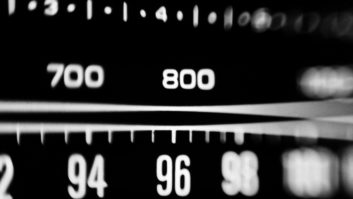It was 12 years ago that I walked into the local electronics store and bought my first car HD Radio receiver. At that time, it was about the only HD Radio receiver you could buy. As soon as I got it in my car, of course, I was tuning up and down the dial to see what stations had HD Radio signals. To my disappointment, I could only find one AM station with a digital signal in my market, and it was only on during the day due to FCC rules for AM HD Radio signals.

If you want to make listeners happy, pay attention to the quality of your signal — including your digital product, which might be overlooked.
credit: iStockPhoto/pidjoe In the coming months I gradually began to hear, one by one, FM stations jump on the digital bandwagon. But I still remember my frustration listening to my radio going back and forth between the analog and digital signal with diversity delay in place. It was unlistenable unless you were in a spot where the digital signal was locked in and stayed constant.
I asked one of the engineers involved with the station about the delay issue. I got back some remark about “making sure that he would get right on it so that I and the other four listeners in the market with HD Radio receivers wouldn’t have to put up with the non-aligned audio.” I am sure he had a point; there were probably many more important items on his agenda. In truth, I might have been the only one in the market with an HD Radio receiver.
However, my concern was for the non-initiated listener who had paid big dollars to buy this latest gadget only to have this frustration and without being able to put it into context. I didn’t want to see this promising technology die an early death because it got a bad reputation.
Fortunately, the technology has advanced to the point that we now take a precisely set diversity delay for granted.
But today we still have to ask, “How important are your HD Radio signals?”
PRIORITY?
The answer is probably going to differ depending not only on your personal view of the technology but by how much those around you prioritize the signals.
Rightfully, analog signals take priority because they generate the ratings and most of the revenue. Recent gains in listenership and revenue with Internet streams and other digital delivery methods have begun to push up this platform in terms of importance as well. Meanwhile, even though the number of HD Radio car receivers continues to grow, HD Radio’s impact on the bottom line of listenership and ad dollars remains hard to measure.
Whether we do it consciously, we generally reflect the priorities and demands of those we work for or with. It’s human nature. If we don’t take on the priorities of our employers we are not going to be employed for long.
Therefore the question of HD Radio being a priority goes beyond the engineering department.
I find that while engineering departments often are champions of HD Radio, interest does not permeate the rest of the staff nearly as much.
Those in programming often look at HD Radio as a necessary evil or worse as something that doesn’t bring ratings and can negatively affect their analog signal. Not too many program directors are very understanding when we have to make the analog audio jump forwards or backwards due to work on whatever device generates our diversity delays. An explanation of why you’re running on the auxiliary transmitter that includes a problem or update to an HD Radio component on the main transmitter is likely to get you a few choice comments about how no one listens to HD Radio. Never mind that they could be losing listeners because you can’t adjust the diversity delay properly without rebooting your HD Radio equipment.
Ownership is supportive of HD Radio or we wouldn’t have any HD Radio signals; there has been considerable investment in transmitters, other equipment used to make the digital signal and the licensing to do it. But that investment probably has a limit; you can only invest so much without seeing a return. This may mean there is no backup HD Radio equipment — which, on its own, is a statement of priority. It says you’re okay with a signal being down for a couple of days to wait for parts.
Obviously, it has been difficult at best for many companies to measure the impact that HD Radio has had on actual revenue. It is understandable that most are not going to invest in a lot of backup equipment when they haven’t seen a significant amount of dollars in return for their initial investment.
I am blessed to work for a company that believes in HD Radio. At the Chicago cluster where I work, we have backup HD Radio equipment and transmitters for all but one signal. This is a great luxury that allows us to keep at full service to all of our audience at all times, whether we are running on the main or backup transmitters.
I find that enthusiasm of HD Radio is somewhat mixed. Most managers embrace it as part of the radio landscape. Having been in their position, I know that the constant in the life of a manager is the need to maintain and increase revenue. HD Radio is hardly a passing thought when it comes to the everyday pursuit of sales and billing. Many may wonder if the dollars and time spent on it could be better spent elsewhere.
IT’S YOUR BABY
This brings us back to the engineering departments, which I maintain most often are the champions of HD Radio. Why? Number one, we interact with the equipment, which the rest of the staff may never have even seen. Two, we are more likely to embrace new technology — at least we’d better be if we want to stay relevant.
For most of us, something like HD Radio is in our “wheelhouse.”
But let’s be honest, how many of even the most enthusiastic engineers will pop out of bed at 2 a.m. to get a digital signal back on the air? As long as the analog signal is on air and producing PPM encoding, most us probably would leave the HD Radio signal issue for daylight hours. Again a statement of priority.
I have seen engineers prioritize their HD Radio signals at various levels. It runs the gamut from the engineer who says “It’s just the HD, no one is listening,” to one who is constantly worried about how the PSD is displaying on their HD3 station.
The “squeaky wheel” syndrome also applies. We don’t often hear complaints about the digital signal. If I have a problem with an analog signal, my cell phone starts blowing up; if the digital is off air, we rarely hear about it. I assume that most of us only hear complaints about the diversity delay, usually someone calling to say their radio has some kind of echo or that it keeps repeating. We once had an advertiser threaten to remove their advertising over a slight bit of difference in diversity delay. While I didn’t like finding out about it from an advertiser, it did show me that with the growth of HD Radio coming standard in vehicles, we will be seeing more of these type complaints if we don’t stay on top of such things.
As to our multicast programs, I have rarely heard a complaint when one is down. That is most likely the experience of most engineers. I have never heard programming complain about an HD2 or HD3 being off air. My experience again is that it was engineering that had to take care of these often neglected stepchildren. At a previous post, we had several extra formats being played out from the local automation system. I would listen to HD2 and hear a lot of silence between songs and sloppily entered imaging. I would mention it to programming and would inevitably get those, “who cares” or “why are you bothering me with this,” expressions on their faces. This is a story that I have heard from other engineers, as well.
Most programmers I encountered worked under the impression that no one really listened to the HD2 and HD3 signals, so why spend time worrying about them. The only time I really saw much attention spent on the multicast channels was when one was being rebroadcast by a translator. Again, it had an analog component to it. I found that I had to intervene to get these stations to sound right. I would spend time editing the crossover points on songs and reproducing imaging that was poorly produced to get these stations sounding good.
I do believe that my story is not isolated. I’ve got a hunch that a lot of engineers have found themselves being the only ones who really care about the HD Radio signals. Maybe as more and more vehicles come with HD Radio receivers as standard, the perception by our fellow staff members will change. By default, they will be listening to HD Radio.
So when you get that first complaint from a program director about diversity delay being off in their car, don’t fluff it off as something that doesn’t affect many listeners. If we don’t take it seriously, we communicate something to the rest of the staff.
Those few complaints I’ve fielded about multicast programming not being on air have come from listeners passionate about both the station and the investment they made in purchasing an HD Radio receiver. I know that it can be easy for us as engineers to “back burner” problems with our HD Radio signals; I know I have done so when everything else seems to be falling apart. But making HD Radio work for the industry starts with good engineering. It won’t work without us.
Rick Sewell, CSRE, AMD, CBNT, spent his first 20 years in radio in positions including on-air, production, programming, sales and management. He finally realized engineering was the most important and he has been doing it full-time for 15 years. He is engineering manager at Crawford Broadcasting’s Chicago Cluster.
Comment on this or any story. Email [email protected].











